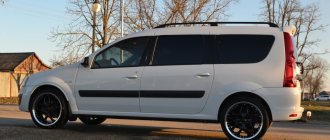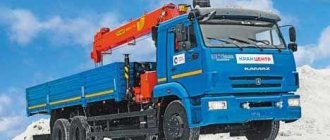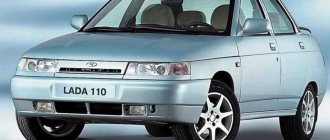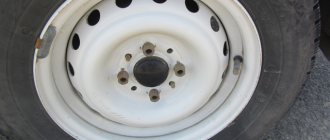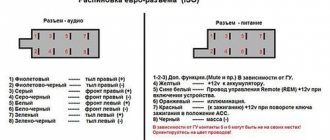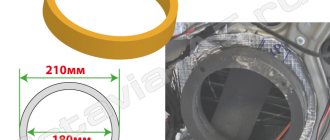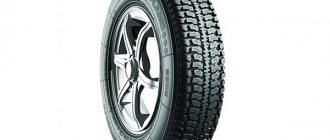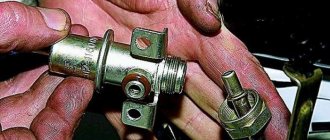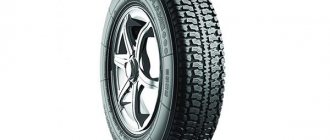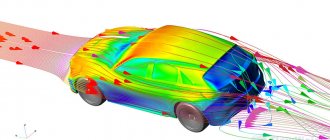Is the pressure in a car’s tires important, how to control it, how much to pump? Some car owners measure pressure by kicking the tire, while others resort to more careful measurements - with a pressure gauge.
Optimal pressure in the tires of a car will allow the driver to fully experience the safety and comfort of driving, while incorrect pressure will cause a lot of trouble.
How is tire pressure measured?
In our country and a number of others, pressure is usually measured in BARs (atmospheres). 1 atm.=1 kgf/cm2. To be extremely precise, 1 atmosphere is equal to 1.0133 bar, but such precision is not needed, it will be concealed by the readings of the pressure gauge, the error of which can reach 2%.
The standard that is common in the USA is PSI (pounds per square inch). To convert PSI to the atmospheres we are familiar with, this value must be divided by 14.5.
Below is a table of approximate ratios of values.
| Pressure Standards | |
| BAR | PSI |
| 1.8 | 26 |
| 1.9 | 28 |
| 2.0 | 29 |
| 2.1 | 30 |
| 2.2 | 32 |
| 2.3 | 33 |
| 2.4 | 35 |
| 2.5 | 36 |
| 2.6 | 38 |
| 2.7 | 39 |
| 2.8 | 41 |
| 2.9 | 42 |
| 3.0 | 44 |
How many atmospheres should a car wheel have?
Passenger car manufacturers recommend inflating tires in the range of 1.9–2.2 atm. Moreover, the wheels
, which are located on the same axis,
must
have the same indicators. Typically, the front tires are inflated slightly less than the rear tires by 0.2 atm.
Interesting materials:
How to easily make a hole in a light bulb? How can you make a brochure? How can I make WhatsApp detailed? How can you make sand-lime brick? How can I make a video from a presentation? How can you make a private profile on Instagram? How to make a photo loop on an iPhone? How to make different wallpapers on two monitors? How to make a blurred background on a Nikon camera? How to make a different background in Photoshop?
When the tire is poorly inflated
If the tire is insufficiently inflated, the pressure of the wheel on the road is uneven, the quality (spot) of adhesion to the road surface decreases, and the tire itself is subject to premature wear. In addition, due to low rolling, fuel consumption increases.
Low tire pressure can be easily determined by its deformation, poor handling, and the car will pull towards the flat tire. In this case, there is a high probability of the frame breaking, damage to the cord threads, which will cause the tire to become unusable. To put it in the language of motorists, it will chew rubber.
VAZ 2114 tires: standard and permissible tire sizes, how much to pump
Using tires that match the recommended dimensions will make driving easier. High-quality tires will make the car more obedient on the road. But it is allowed to use wheels of a different size from the standard one.
It should be noted: tires from various manufacturers were installed on the VAZ 2114 from the factory. The reason for this is simple: this model was produced for several years in a row. At the same time, every year the manufacturer purchased relatively large quantities of goods from one brand. After the entire batch was completed, the purchase was carried out again.
At the same time, the wheel width and profile height remained the same. Correctly selected tires make the car as obedient as possible on the road and help avoid accidents. Wheels with a diameter of 13 inches are supplied as standard. However, if desired, you can easily install 14-inch tires. Standard tires recommended by the manufacturer:
- 175/70R13 82T;
- 175/70R13 82H.
The speed index differs slightly in the modifications indicated above. An important difference between this car model is the permissibility of installing tires with the M+S mark. This suggests the possibility of using so-called “Velcro”. It allows you to move comfortably at any time of the year – at minus and plus temperatures.
However, it is worth remembering: it is advisable to have two separate sets for winter and summer. Studded tires will significantly reduce the braking distance and avoid an accident. The presence of studs makes it possible to easily control the behavior of the vehicle on the road.
If the wheel is overinflated
An overinflated tire becomes too hard. It rolls easily, but like a flat tire, it has insufficient grip on the road, and this is fraught with accidents. The car will jump excessively, increasing the load on the body and suspension elements, and if it gets into a hole, the tire may simply burst.
When the machine is heavily loaded, it is not recommended to greatly increase the tire pressure, since all of the above risks can only intensify.
When you need to lower your tires a little
In some cases, there are recommendations to slightly lower the tire pressure than specified in the recommendations. There are two such cases:
- In winter, if the pressure is a little less, then better traction occurs. But as the temperature changes, the internal volume in the tire also changes.
- The most popular use for slightly lowered wheels is off-road driving. In this case, the wheels will act on the principle of tracks. Which will increase cross-country ability.
But it is difficult for an inexperienced driver to determine by what indicators to reduce the pressure. Therefore, we do not recommend experimenting.
Conclusion: the pressure in car tires must be checked regularly, maintained at the level recommended by the manufacturer, and weather and road conditions taken into account. This will extend their life and help make your ride safer.
What should the pressure be?
The recommended tire pressure is usually determined by the vehicle manufacturer. There are a number of other factors, such as:
- vehicle's own weight;
- disc diameters;
- tire indices and markings.
You can find out what tire pressure should be in your tires from signs placed on the door pillar, gas filler flap or glove compartment. It is recommended to take measurements only when the tire is cold, since as it moves it heats up and the air inside expands, which gives a serious error in measurements.
For greater clarity, below is a table of tire pressures by car brand.
The specified values are recommended by car manufacturers.
What happens if tire pressure is not maintained?
Most cars with front-wheel drive (both domestic and foreign production) can be equipped with rims with a radius of R13 - R16. However, the basic package almost always includes wheels of sizes R13 and R14. The optimal pressure in a car's tires is selected according to its weight when fully loaded. In this case, the climatic and road conditions in which the vehicle is operated must be taken into account.
If the wheels are not inflated correctly
- Driving the car will become difficult; you will have to exert more effort to turn the steering wheel;
- tread wear will increase;
- fuel consumption will increase while driving on flat tires;
- the car will skid more often, which is especially dangerous when driving in icy conditions or on a wet road;
- there will be a decrease in the dynamic power of the vehicle due to a constant increase in the force of resistance to movement.
If the wheels are overinflated
- The wear of chassis parts increases. At the same time, while driving, you can feel all the bumps and holes on the road. Comfort when driving disappears;
- Since the tire pressure of the car becomes excessive, as a result, the contact area of the tire tread with the road surface decreases. Because of this, the braking distance significantly increases and the safety of vehicle operation decreases;
- the tread wears out faster, significantly reducing the service life of car tires;
- Excessive pressure in tires upon contact with an obstacle at high speed can cause the formation of a hernia, or even rupture of the rubber. This situation is extremely dangerous and can lead to tragic consequences.
Most owners of transport equipment with R13 and R14 wheels (the most common radius sizes) are interested in: what should be the optimal pressure in the car tires? According to the manufacturer's recommendation, tires of the thirteenth radius must be inflated to 1.9 kgf/cm 2, and wheels of size R14 - to 2.0 kgf/cm 2. These parameters apply to both front and rear wheels.
Dependence of tire pressure on climatic and road conditions
In principle, it is necessary to maintain the same tire inflation in both summer and winter. However, it is recommended to slightly underinflate the tires in winter. This is necessary for:
- Increasing vehicle stability on slippery roads. Driving a vehicle becomes more convenient and comfortable with slightly flat tires in winter.
- Road safety is improved because the vehicle's braking distance is significantly reduced.
- Lowered tires in winter soften the suspension, making the poor condition of the road surface less noticeable. Increases comfort when moving.
You also need to know that with a sharp change in temperature (for example, after the car has left a warm box in the cold), due to certain physical properties, the pressure in the tires decreases.
Therefore, before leaving the garage in winter, it is necessary to check the tire pressure and, if necessary, inflate them. Do not forget about constant monitoring of pressure, especially when the temperature changes and in the off-season.
The recommended pressure in R13 tires with the onset of summer is 1.9 atm, this value is calculated taking into account the fact that the car will be half loaded (driver and one or two passengers). When the vehicle is fully loaded, the pressure of the front wheel pair must be increased to 2.0-2.1 atm, and the rear wheel pair - to 2.3-2.4 atm. The spare tire should be inflated to 2.3 atm.
Unfortunately, the road surface is by no means ideal, so most motorists specifically prefer not to inflate their tires a little. Because thanks to this, all the unevenness and imperfections of the road are not so felt when driving. Often in summer the tire pressure is reduced by 5-10%, and with the onset of winter this figure increases slightly and amounts to 10-15%. When driving on roads with smooth surfaces, it is best to maintain the tire pressure recommended by the manufacturer.
Taking into account all factors, a tire pressure table is constructed.
| Disc size and radius | Tire pressure, kgf/cm2 |
| 175/70 R13 | 1,9 |
| 175/65 R13 | 1,9 |
| 175/65 R14 | 2,0 |
| 185/60 R14 | 2,0 |
What should be the optimal pressure for larger wheels?
Despite the fact that most domestic and foreign cars have wheels with a maximum radius of R14, most owners, in order to improve the appearance of their vehicle and improve some of its characteristics, install wheels of a larger radius (R15 and R16). Therefore, it is necessary to know what the optimal pressure should be for tires of this size?
Here, too, everything depends on the degree of loading of the machine. When it is half loaded, the tire pressure threshold should not exceed 2.0 kgf/cm2; when fully loaded, this value is already 2.2 kgf/cm2. If a large amount of various heavy luggage is transported in the luggage compartment, the pressure in the rear wheel pair must be increased by another 0.2 kgf/cm 2 . As you can see, the pressure in tires of the fourteenth radius is approximately equal to the pressure in R15 and R16.
Table
| car brand | Dimensions | Pressure (front/rear) |
| vaz/lada | ||
| 2104 | 165/80 R13 | 1.6/2.1 |
| 175/70 R13 | 1.6/2.2 | |
| 2106 | 165/80 R13 | 1.6/1.9 |
| 175/70 R13 | 1.7/2.0 | |
| 165/70 R13 | 1.8/2.1 | |
| 2107 | 165/80 R13 | 1.6/1.9 |
| 175/70 R13 | 1.7/2.0 | |
| 2109/21099 | 165/70 R13 | 1.9/1.9 |
| 175/70 R13 | 1.9/1.9 | |
| 155/80 R13 | 1.9/1.9 | |
| 2110/2111/2112 | 175/70 R13 | 1.9/1.9 |
| 175/65 R14 | 1.8/1.8 | |
| 185/60 R14 | 1.8/1.8 | |
| 2114/2115 | 165/70 R13 | 1.9/1.9 |
| 175/70 R13 | 1.9/1.9 | |
| vesta | 185/65 R15 | 2.1/2.1 |
| 195/55 R16 | 2.1/2.1 | |
| granta | 175/70 R13 | 1.9/2.1 |
| 175/65 R14 | 2.0/2.2 | |
| Granta liftback | 175/65 R14 | 2.0/2.2 |
| 185/60 R14 | 2.0/2.2 | |
| 185/55 R15 | 2.0/2.2 | |
| viburnum (kalina) | 175/70 R13 | 1.9/1.9 |
| Kalina station wagon/hatchback | 185/60 R14 | 1.9/1.9 |
| priora | 175/70 R13 | 1.9/1.9 |
| 185/60 R14 | 1.9/1.9 | |
| Largus/Largus cross | 185/70 R14 | 2.4/2.6 |
| 185/65 R15 | 2.4/2.6 | |
| Niva | ||
| 2121/21213/21214/2131 | 175/80 R16 | 2.1/1.9 |
| 185/75 R16 | 2.1/2.0 | |
| gas | ||
| 3110/31105 | 195/65 R15 | 2.0/2.1 |
| 3307/3309 | 8.25R20 | 4.5/6.3 |
| 3308 | 12.00R18 | 3.5/4.5 |
| 53 | 8.25R20 | 4.0/6.3 |
| 66 | 8.00R18 | 2.8/2.8 |
| gazelle | ||
| 2705 (business) | 185/75 R16 | 3.0/3.0 |
| 3302 (cargo) | 185/75 R16 | 3.0/3.0 |
| next | 185/75 R16 | 3.6/2.9 |
| passenger | 185/75 R16 | 3.0/3.0 |
| sable | 215/65 R16 | 2.7/2.7 |
| sable 2752 | 185/75 R16 | 3.3/3.9 |
| Valdai | 215/75 R17 | 5.4/6.3 |
| lawn next | 185/75 R16 | 3.3/3.9 |
| zil | ||
| 130/131 | 9.00R20 | 4.5/6.0 |
| 5301 (bull) | 225/75 R16 | 5.0/6.0 |
| UAZ | ||
| 469 | 235/70R16 | 2.0/2.3 |
| patriot | 225/75R16 | 2.0/2.4 |
| 235/70R16 | 1.9/2.2 | |
| 245/70R16 | 1.8/2.1 | |
| 245/60R18 | 1.8/2.0 | |
| loaf | 225/75R16 | 2.0/2.3 |
| hunter | 225/75R16 | 2.0/2.3 |
| 235/70R16 | 2.1/2.4 | |
| KAMAZ | ||
| 4308 | 245/70R19.5 | 4.8/4.8 |
| 4310 | 245/70R19.5 | 4.8/4.8 |
| 43118 | 425/85R21 | 5.6/5.6 |
| other | ||
| maz | 235/75R17.5 | 6.5/7.3 |
| oka | 135/80R12 | 1.8/1.8 |
| Ural 4320 | 390/95R20 | 4.0/4.0 |
| groove 32053 | 245/70R19.5 | 5.6/4.6 |
| audi | ||
| a4 | 225/50R17 | 2.3/2.3 |
| 235/40R18 | 2.5/2.5 | |
| 245/45R17 | 2.2/2.1 | |
| q5 | 235/65R17 | 2.1/2.1 |
| 235/60R18 | 2.1/2.1 | |
| 235/55R19 | 2.1/2.1 | |
| 255/45R20 | 2.1/2.1 | |
| bmw | ||
| x5 | 235/65R17 | 2.2/2.2 |
| 255/55R18 | 2.2/2.2 | |
| 255/50R19 | 2.1/2.5 | |
| e39 | 225/60R15 | 2.0/2.2 |
| 205/65R15 | 2.2/2.4 | |
| 235/40R18 | 1.9/2.3 | |
| 265/35R18 | 2.3/2.7 | |
| 225/55R16 | 2.3/2.7 | |
| 235/45R17 | 2.5/2.7 | |
| x1 | 225/50R17 | 2.2/2.7 |
| 225/45R18 | 2.5/2.7 | |
| daewoo | ||
| matiz | 145/70R13 | 1.9/1.9 |
| 155/65R13 | 1.9/1.9 | |
| nexia | 175/70R13 | 2.0/2.1 |
| 185/60R14 | 2.2/2.4 | |
| dodge | ||
| caliber | 215/60R17 | 2.2/2.2 |
| 215/55R18 | 2.2/2.2 | |
| 225/45R19 | 2.2/2.2 | |
| caravan | 215/65R15 | 2.2/2.3 |
| ford | ||
| focus 3 | 195/65R15 | 2.1/2.1 |
| 205/55R16 | 2.1/2.1 | |
| 205/50R17 | 2.1/2.1 | |
| 225/40R18 | 2.1/2.1 | |
| kuga | 235/55R17 | 2.4/2.4 |
| 235/50R18 | 2.3/2.3 | |
| 235/45R19 | 2.3/2.3 | |
| mondeo 4 | 185/65R14 | 2.1/2.1 |
| 195/60R14 | 2.1/2.1 | |
| 205/55R15 | 2.1/2.1 | |
| transit | 195/70R15 | 3.4/2.7 |
| 195/65R16 | 3.7/4.0 | |
| 205/75R16 | 3.0/3.9 | |
| 215/75R16 | 3.0/4.0 | |
| focus 1 | 185/65R14 | 2.2/2.2 |
| 195/55R15 | 2.0/2.0 | |
| 205/50R16 | 2.2/2.2 | |
| 185/60R15 | 2.2/2.2 | |
| 215/40R17 | 2.2/2.2 | |
| focus 2 | 195/65R15 | 2.1/2.1 |
| 205/55R16 | 2.1/2.1 | |
| 225/40R18 | 2.1/2.1 | |
| fusion | 195/60R15 | 2.4/2.2 |
| 195/55R16 | 2.4/2.2 | |
| Explorer 5 | 235/75R15 | 2.1/2.4 |
| 225/70R15 | 2.1/2.4 | |
| fiat (fiat) | ||
| ducato | 195/70R15 | 4.1/4.5 |
| 205/70R15 | 4.1/4.5 | |
| 215/75R16 | 4.5/4.5 | |
| Jeep (jeep) | ||
| Grand Cherokee | 225/75R16 | 2.3/2.3 |
| 235/65R17 | 2.3/2.3 | |
| 235/70R16 | 2.3/2.3 | |
| 245/60R18 | 2.3/2.3 | |
| Hyundai | ||
| 78 | 175/60R14 | 2.3/2.3 |
| 175/50R15 | 2.3/2.3 | |
| ix35 | 215/70R16 | 2.3/2.3 |
| 225/60R17 | 2.3/2.3 | |
| accent | 155/80R13 | 2.1/2.1 |
| 185/60R14 | 2.1/2.1 | |
| 175/70R14 | 2.1/2.1 | |
| 195/55R15 | 2.1/2.1 | |
| Creta (Greta) | 215/65R16 | 2.3/2.3 |
| porter 2 (portrer) | 185/80R14 | 3.0/4.5 |
| solaris | 185/65R15 | 2.2/2.2 |
| 195/55R16 | 2.2/2.2 | |
| tucson | 215/65R16 | 2.1/2.1 |
| 235/60R16 | 2.1/2.1 | |
| getz | 155/80R13 | 2.1/2.1 |
| 175/65R14 | 2.1/2.1 | |
| 185/55R15 | 2.1/2.1 | |
| santa fe | 215/70R15 | 2.1/2.1 |
| 225/70R16 | 2.1/2.1 | |
| 235/70R16 | 2.1/2.1 | |
| 235/60R18 | 2.1/2.1 | |
| Chery | ||
| Cherie Tiggo (tiggo) | 225/65R17 | 2.3/2.3 |
| Chevrolet | ||
| aveo | 155/80R13 | 2.1/2.1 |
| 185/60R14 | 2.1/2.1 | |
| 195/65R15 | 2.5/2.5 | |
| 205/55R16 | 2.5/2.5 | |
| cobalt | 185/75R14 | 2.5/2.5 |
| 195/65R15 | 2.4/2.4 | |
| lanos | 175/70R13 | 2.2/2.2 |
| 185/60R14 | 2.2/2.2 | |
| Lacetti | 195/55R15 | 2.3/2.3 |
| Chevy Niva | 205/65R15 | 2.1/2.1 |
| 205/70R15 | 2.1/2.1 | |
| 215/65R16 | 2.2/2.2 | |
| captiva | 215/70R16 | 2.1/2.1 |
| 235/55R18 | 2.1/2.1 | |
| Cruze | 205/60R16 | 2.2/2.2 |
| 215/55R17 | 2.2/2.2 | |
| Kia | ||
| picanto | 155/70R13 | 2.1/2.1 |
| 165/60R14 | 2.1/2.1 | |
| 175/50R15 | 2.1/2.1 | |
| rio | 155/80R13 | 2.1/2.1 |
| 175/70R13 | 2.1/2.1 | |
| 175/70R14 | 2.1/2.1 | |
| 185/65R15 | 2.1/2.1 | |
| 195/55R15 | 2.2/2.2 | |
| 195/55R16 | 2.2/2.2 | |
| seed | 185/65R15 | 2.2/2.2 |
| 225/45R17 | 2.2/2.2 | |
| sorento | 225/75R16 | 2.5/2.5 |
| 245/70R16 | 2.5/2.5 | |
| 235/65R17 | 2.2/2.2 | |
| 235/60R18 | 2.3/2.3 | |
| sportage (3, 4, 2016) | 205/70R15 | 1.8/1.8 |
| 215/65R16 | 2.1/2.1 | |
| 235/60R16 | 2.1/2.1 | |
| 215/70R16 | 2.3/2.3 | |
| 225/60R17 | 2.3/2.3 | |
| cerato | 195/60R15 | 2.1/2.1 |
| 205/50R16 | 2.1/2.1 | |
| Lexus (Lexus) | ||
| 570 | 285/60R18 | 2.3/2.6 |
| 285/50R20 | 2.3/2.6 | |
| rx350 | 225/60R17 | 2.1/2.1 |
| 235/55R18 | 2.2/2.2 | |
| 235/60R18 | 2.3/2.3 | |
| 235/55R19 | 2.3/2.3 | |
| Mitsubishi (Mitsubishi) | ||
| Lancer 10 (9) | 195/60R15 | 2.2/2.1 |
| 195/50R16 | 2.3/2.1 | |
| 235/45R17 | 2.2/1.9 | |
| 205/60R16 | 2.2/2.2 | |
| 215/45R18 | 2.2/2.2 | |
| Outlander | 215/55R16 | 2.1/2.0 |
| 215/70R16 | 2.2/2.2 | |
| 215/55R17 | 2.2/2.2 | |
| 225/55R18 | 2.2/2.2 | |
| Pajero 4 (pajero) | 265/65R17 | 2.2/2.4 |
| 265/60R18 | 2.2/2.4 | |
| Mercedes (Mercedes) | ||
| sprinter | 225/70R15 | 2.8/4.0 |
| Mazda (Mazda) | ||
| 3 | 195/65R15 | 2.2/2.2 |
| 205/60R15 | 2.5/2.3 | |
| 205/55R16 | 2.2/2.2 | |
| 6 | 195/65R15 | 2.2/2.2 |
| 195/65R16 | 2.2/2.2 | |
| 205/55R16 | 2.2/2.2 | |
| 215/45R17 | 2.2/2.2 | |
| 215/50R17 | 2.2/2.2 | |
| 215/45R18 | 2.2/2.2 | |
| cx 5 | 225/65R17 | 2.3/2.3 |
| 225/55R19 | 2.5/2.5 | |
| cx 7 | 235/60R18 | 2.2/2.2 |
| 235/55R19 | 2.2/2.2 | |
| Nissan | ||
| Qashqai | 215/65R16 | 2.3/2.3 |
| 215/60R17 | 2.3/2.3 | |
| 215/55R18 | 2.3/2.3 | |
| almera/classic | 185/65R15 | 2.0/2.0 |
| 195/60R15 | 2.0/2.0 | |
| 195/55R16 | 2.0/2.0 | |
| laptop (note) | 185/65R15 | 2.3/2.1 |
| 175/65R15 | 2.3/2.1 | |
| 185/55R16 | 2.3/2.1 | |
| teana | 205/65R16 | 2.2/2.0 |
| 215/55R17 | 2.2/2.0 | |
| tiida | 185/65R15 | 2.3/2.1 |
| 195/65R16 | 2.3/2.1 | |
| x trail (x-trail) | 215/70R15 | 2.2/2.2 |
| 215/65R16 | 2.2/2.2 | |
| x trail t31 | 215/65R16 | 2.3/2.1 |
| 225/60R17 | 2.3/2.1 | |
| 225/55R18 | 2.3/2.1 | |
| Opel (Opel) | ||
| astra jh (astra) | 225/55R17 | 2.2/2.2 |
| 235/55R17 | 2.2/2.2 | |
| 235/50R18 | 2.2/2.2 | |
| 245/45R18 | 2.2/2.2 | |
| 235/45R19 | 2.2/2.2 | |
| 245/40R20 | 2.2/2.2 | |
| corsa | 185/70R14 | 2.0/1.8 |
| 185/65R15 | 2.0/1.8 | |
| 195/60R15 | 2.0/1.8 | |
| 195/55R16 | 2.0/1.8 | |
| 215/45R17 | 2.0/1.8 | |
| Peugeot | ||
| 206 | 165/70R13 | 2.2/2.2 |
| 175/65R14 | 2.4/2.4 | |
| 185/55R15 | 2.3/2.3 | |
| 205/45R16 | 2.3/2.3 | |
| 307 | 195/65R15 | 2.3/2.3 |
| 205/55R16 | 2.5/2.5 | |
| 205/50R17 | 2.5/2.5 | |
| 308 | 195/65R15 | 2.3/2.3 |
| 205/55R16 | 2.4/2.4 | |
| 215/55R16 | 2.5/2.5 | |
| 225/45R17 | 2.5/2.5 | |
| 225/40R18 | 2.7/2.7 | |
| boxer | 195/70R15 | 4.1/4.5 |
| 205/70R15 | 4.1/4.5 | |
| 205/75R16 | 4.5/4.7 | |
| 215/75R16 | 4.5/4.7 | |
| 215/70R15 | 4.1/4.1 | |
| 215/70R16 | 5.0/5.0 | |
| 225/75R16 | 4.6/5.1 | |
| partner | 165/70R14 | 2.4/2.6 |
| 175/65R14 | 2.6/2.6 | |
| 185/65R15 | 2.0/2.2 | |
| 195/65R15 | 2.3/2.3 | |
| Renault (Renault) | ||
| sandero | 185/65R15 | 2.2/2.2 |
| 195/55R16 | 2.2/2.2 | |
| simbol | 175/70R13 | 1.9/2.1 |
| 175/65R14 | 1.9/2.1 | |
| 185/60R14 | 2.2/2.4 | |
| 185/55R15 | 2.3/2.5 | |
| duster | 215/65R16 | 2.0/2.0 |
| logan | 165/80R14 | 2.0/2.0 |
| 185/65R15 | 2.1/2.0 | |
| Megane 2 | 195/65R15 | 2.4/2.0 |
| 205/55R16 | 2.2/2.0 | |
| 205/50R17 | 2.2/2.0 | |
| 205/55R17 | 2.2/2.0 | |
| SsangYong | ||
| Kyron | 225/75R16 | 2.3/2.3 |
| 235/75R16 | 2.1/2.1 | |
| 255/60R18 | 2.1/2.1 | |
| Subaru (subaru) | ||
| outback | 185/70R14 | 2.2/2.1 |
| 195/60R15 | 2.2/2.1 | |
| 205/50R16 | 2.3/2.2 | |
| 215/60R16 | 2.0/2.0 | |
| 205/55R16 | 2.2/2.2 | |
| 215/45R17 | 2.2/2.2 | |
| 215/50R17 | 2.5/2.4 | |
| 215/55R17 | 2.2/2.0 | |
| 225/60R17 | 2.3/2.2 | |
| Suzuki | ||
| grand vitara | 195/80R15 | 1.8/1.8 |
| 205/75R15 | 1.8/1.8 | |
| 215/65R16 | 1.8/2.1 | |
| 235/60R16 | 1.8/1.8 | |
| 215/70R15 | 2.2/2.2 | |
| 225/65R17 | 2.2/2.2 | |
| Toyota | ||
| rav4 (rav 4) | 215/70R16 | 2.0/2.0 |
| 235/60R16 | 2.0/2.0 | |
| 225/65R17 | 2.2/2.2 | |
| 235/55R18 | 2.2/2.2 | |
| land cruiser prado | 215/80R16 | 2.2/2.2 |
| land cruiser prado | 265/70R16 | 2.6/2.4 |
| 100, 120, 150, 200 | 225/70R17 | 2.4/2.4 |
| 265/65R17 | 2.4/2.4 | |
| auris | 195/65R15 | 2.2/2.2 |
| 205/55R16 | 2.3/2.3 | |
| 225/45R17 | 2.3/2.3 | |
| camry | 205/65R15 | 2.3/2.3 |
| 215/60R16 | 2.1/2.1 | |
| corolla | 155/80R13 | 2.1/2.0 |
| 165/70R14 | 2.2/2.2 | |
| 175/65R14 | 2.2/2.2 | |
| 185/65R14 | 2.2/2.2 | |
| 185/55R15 | 2.2/2.2 | |
| 195/55R15 | 2.2/2.2 | |
| Volkswagen (volkswagen) | ||
| b5, b6 | 195/65R15 | 1.9/1.9 |
| 205/60R15 | 2.4/2.2 | |
| 205/55R16 | 2.0/1.9 | |
| 225/45R17 | 2.3/2.1 | |
| polo sedan (polo) | 195/55R15 | 2.0/1.9 |
| 205/45R16 | 2.3/2.1 | |
| tiguan | 215/65R16 | 2.2/2.2 |
| 215/60R17 | 2.2/2.2 | |
| 235/55R17 | 2.2/2.2 | |
| 235/50R18 | 2.2/2.2 | |
| Tuareg (Tuareg) | 235/65R17 | 2.3/2.5 |
| 255/60R17 | 2.3/2.5 | |
| 255/55R18 | 2.3/2.5 | |
| 265/50R19 | 2.3/2.5 | |
| 275/45R20 | 2.3/2.5 | |
| 275/40R21 | 2.3/2.5 | |
| Volvo (Volvo) | ||
| xc90 | 235/65R17 | 2.2/2.7 |
| 235/60R18 | 2.7/2.7 | |
| 255/50R19 | 2.4/2.4 | |
| 255/45R20 | 2.4/2.4 | |
| Scoda (Skoda) | ||
| Octavia A5 (octavia) | 195/65R15 | 2.2/2.2 |
| 205/60R15 | 2.1/2.2 | |
| 205/55R16 | 2.2/2.2 | |
| 225/45R17 | 2.2/2.2 | |
| Octavia A7 | 195/65R15 | 2.2/2.3 |
| 205/55R16 | 2.1/2.1 | |
| 205/50R17 | 2.1/2.1 | |
| 225/45R17 | 2.1/2.1 | |
| 225/40R18 | 2.0/2.1 | |
| rapid | 185/60R15 | 2.2/2.4 |
| 195/55R15 | 2.2/2.4 | |
| 215/45R16 | 2.2/2.3 | |
| 215/40R17 | 2.2/2.3 | |
| Honda | ||
| CRV | 205/70R15 | 1.8/1.8 |
| 205/65R16 | 1.8/1.8 | |
| 215/65R16 | 2.1/2.0 | |
Factors requiring adjustment of tire pressure
The point is also that depending on the nature of the movement and the characteristics of the load, different pressure is required. Here are the main factors that must be taken into account when correcting the degree of tire inflation:
- model, make and, accordingly, weight of the car;
- tire size;
- season – cold or warm;
- driving habits and road type;
- driving around the city or on the highway;
- number of passengers in the car;
- engine type: diesel or gasoline.
- presence of cargo in the car;
- wheel type: front or rear.
Tire pressure
You can find information on the recommended value for your model on the gas tank door or in any other place. We present several options in the photo. You need to be guided not by advice, but by the manufacturer’s recommendations. They are indicated, as a rule, for a temperature of 22◦C, that is, summer time. The pressure in winter tires R16, as well as R14 and R15, is reduced to improve the grip of the wheels on the road, in other words, they make the movement heavier, which is very convenient in snow and ice.
The nature and measures to reduce road safety are well illustrated by the table, which reflects changes in the nature of the passive safety of a passenger car.
Tire pressure measurement
Table 1. Effect of tire pressure on safety and wear resistance:
| Changing the pumping indicator | Nature of influence |
| Normal | Vehicle safety and controllability Sufficient mileage Normal fuel consumption |
| — 0.5 bar | An increase in tread wear by 20%, the possible mileage is approximately reduced by 8 thousand km. |
| — 1 bar | Dangerous driving parameters, additional fuel consumption. |
| — 1.5 bar | The car may lose control of the road |
| — 2 bars | Braking distance on wet asphalt increases to 11 m. |
Note! A wheel that has been used in a poorly inflated condition may explode when the parameters are restored, and this can happen right on the road.
By the nature of wear, you can determine whether increased or decreased parameters usually occur on your model. This is well illustrated in the photo.
Standard wheel parameters and, accordingly, tread inflation are usually assessed at a summer temperature of 22°C; in cold weather, the parameters decrease, and with increased load and driving on the highway, they increase. Please note that the front wheels are pumped up 10% more, this is done so that the rear of the front-wheel drive model does not skid, and it maintains directional stability better.
Inflating tires on a car
With all-wheel drive, the wheels are inflated equally. This also directly depends on the weight distribution parameter. If it is 50*50, it is inflated to equal values, if there is a weight distribution or the vehicle is loaded, then the rear wheels are inflated more for freer movement.
In cold weather, for driving on a snowy road, it is recommended to increase the pumping; if driving on ice is meant, it is reduced. Thus, protectors are a completely reliable system for controlling directional stability, but only if you have certain knowledge that depends on a number of parameters. To illustrate what has been said, we present tables.
Table 2. The degree of inflation in wheels with and without a load using the example of some brands:
| Model and modification of a passenger model | Tire sizes | Inflation level | ||||
| Front | Rear | Standard | With load | |||
| Front | Rear | Front | Rear | |||
| Lanos 1.5i SE-SX & Auto | 175/70 R13 T | 2,2 | 2,2 | 2,2 | 2,2 | |
| Matiz 0.8i S-SE & Auto | 145/70 R13 T | 1,9 | 1,9 | 2,1 | 2,3 | |
| 155/65 R13 T | 1,9 | 1,9 | 2,1 | 2,3 | ||
| Nexia 1.5i GL & Auto | 175/70 R13 T | 2,6 | 2,1 | 2,6 | 2,1 | |
| Nexia 1.5i GLX-GTX & Auto | 185/80 R13 T | 2,2 | 2,4 | 2,2 | 2,4 | |
| VAZ 2104 | 165/80 R13 T | 1,6 | 2,1 | 1,7 | 2,3 | |
| 175/70 R13 T | 1,6 | 2,2 | 1,7 | 2,2 | ||
| VAZ 2108/09/99 | 165/80 R13 T 175/70 R13 T 155/80 R13 T | 1,9 | 1,9 | 2,0 | 2,0 | |
| 1,9 | 1,9 | 2,0 | 2,0 | |||
| VAZ 2110 and Lada Priora | 175/70 R13 T | 1,9 | 1,9 | 2,0 | 2,0 | |
| 175/65 R14 T | 2,0 | 2,0 | 2,1 | 2,1 | ||
| 185/60R14T | 2,0 | 2,0 | 2,1 | 2,1 | ||
The pressure in R15 tires in winter should be 2.3 and 2.6 (185/65 R15 - 2.4 and 2.6), in R16 - 2.3-2.8, but these values are advisory, exact numbers are always are unique to each model and are usually written on the fuel tank cap. However, it does not indicate what parameters should be in winter. Let's consider this issue in more detail.
Tire pressure characteristics
How to calculate the degree of tire inflation in winter, based on the manufacturer’s official data. Of course, it is better to use the official recommendations of the car manufacturer or service, but you can be guided by general theoretical knowledge.
The general theory is related to the physics of gaseous media. What does it mean? As the temperature drops, the degree of inflation also decreases, so to improve cross-country ability it is necessary to inflate the tread. You can adhere to the following recommendations:
- when the temperature decreases, to maintain or improve the tire's cross-country ability, the tire should be 0.1-0.2 units more;
- if you need to maintain controllability in icy conditions, the parameters remain the same as in the summer, to a lesser extent this applies to the R16;
- if the weight distribution is the same, the products are inflated equally, while at maximum load the rear group is inflated by 0.2;
- in R14 tires the pressure is within 2.0 bar, in other sizes, respectively, less or more (R16);
- You can pump up the wheels that are driving more.
Winter tire pressure
The optimal pressure in car tires in winter and summer may differ slightly. In winter, wheels can be inflated 0.2-0.3 atmospheres more than in summer. This is due to the fact that when the air heats up, the pressure inside the wheel increases, and when it cools, it decreases. This means that an equal volume of air in winter and summer will have different values.
| Size | In summer | in winter |
| R13 | 1.9 | 2.1 |
| R14 | 2.0 | 2.2 |
| R15 | 2.0 | 2.2 |
| R16 | 2.0 | 2.2 |
| R17 | 2.2 | 2.4 |
How to check the tire pressure of a vehicle
The check is carried out using a special device - a pressure gauge; it must be checked before the car starts moving and always on a cold tire. You can buy a pressure gauge at your nearest automotive store. Pressure gauges come in several varieties: pointer, mechanical and electronic; the differences are only in the principle of operation, and their readings may vary slightly. Which type of device to buy depends on the thickness of the wallet. Any compressor or pump that is used to inflate wheels is equipped with a pressure gauge. It can also be used to measure tire pressure.
If you checked the pressure with a pressure gauge and found that the readings are far from the required ones, and there is nothing to inflate the tire with, do not despair, now most gas stations are equipped with compressor units, using which you can easily and quickly inflate the tires (this is an absolutely free service). If you accidentally overinflated the wheel, simply press the nipple and release the “extra” air. Driving for a long time in a car whose tires are over-inflated, or, conversely, not inflated at all, is fraught with unpleasant consequences.
When a car's tires are poorly inflated (below the required level), this, first of all, quickly wears out even “fresh” tires, and secondly, it leads to an increase in fuel consumption. Why is this happening? It's simple. Due to weak inflation, the tire is subject to deformation, which leads to an increase in resistance and rapid heating of the rubber. What is most important is that only the edges of the wheel wear out, and with normal inflation, rubber wear occurs evenly, since the entire surface of the tire is in contact with the road surface. The most unpleasant thing is that the car becomes virtually uncontrollable, directional stability is lost, and as it moves, the wheels can spontaneously “disassemble”, the vehicle stops turning normally, the braking distance increases, etc.
To drive 20,000 kilometers on poorly inflated tires, you will need an additional 540 liters of gasoline, which will add up to a tidy sum.
By overinflating your tires, you will also experience deterioration in your car's handling, as the tires' grip on the road decreases. The load on the suspension also increases, which seriously reduces their service life, wear occurs and the suspension fails.
Constantly driving on tires with high pressure leads to wheel deformation and wear of the central part of the tire. Vehicle handling becomes more rigid, and long-term use of a car with such tires will cause many problems.
This can be easily avoided by knowing a simple rule:
Pressure adjustment should be done on “cold” tires.
The vehicle should stand motionless for several hours (during driving, the tires heat up, which leads to an increase in pressure, this is worth taking into account, because the recommended pressure is indicated for unheated tires).
Winter tires
A few words about winter tires. When inflating tires in a heated garage in winter, remember that the pressure can be exceeded by 0.2 atmospheres. This is correct for regular winter tires and their studded variants. Why exceed the norm? It's simple: when leaving a warm garage, the tires gradually cool down, therefore, the pressure in them drops.
Have you read the article but still have some unclear points? It's time to contact our specialists (numbers below), who will answer all your questions on this topic.
Pressure monitoring using instruments
Most drivers do not want to check their pressure often. The reasons are different: dirty wheels, the “painstaking” procedure - unscrew the cap and measure with a pressure gauge. Indicator caps were invented for such “lazy people”; they display tire pressure.
They are mounted directly on the valve, everything is already set to a pressure of 1.8 - 4 atmospheres. The devices are universal and can be installed on any valves of tubes and tubeless tires of motorcycles, cars, trucks, buses and other vehicles.
The color pressure sensor is installed in place of the standard cap. The condition of the tire is determined by the rod with sectors of different colors. A green mark means everything is normal. The yellow sector will report a pressure drop of 0.3 atmospheres below normal.
At this pressure, movement is permissible at a speed not exceeding 50 km/h. The red sector signal means that the tire pressure has dropped to an unacceptable value - by 0.7 atmospheres or more, this requires immediate tire inflation.
The use of measuring devices is most widespread on cars of the middle and executive classes. They are equipped with light and sound indications and display readings on the monitor, so the driver will immediately know about any changes. We wrote in more detail about such control systems in this article.
What are the dangers of driving on improperly inflated tires?
Many novice motorists have the misconception that an overinflated tire is preferable to an underinflated one. An argument for this can be that on hypercars the tire pressure is usually higher than normal. In fact, any pressure deviation from normal values has an equally negative effect on the tires. Thus, with insufficient pressure, the contact area of the tread with the road surface increases, which causes greater wear at the edges.
Insufficient tire pressure is indicated by:
- increased fuel consumption by 10-20%;
- cornering with great effort;
- the car moves to the side when driving at speeds above 50 km/h.
When the normal pressure value is exceeded, the tread has a smaller contact area with the blade, therefore increased wear is observed in the center. Tire pressure that is too high is indicated by:
- loss of control when cornering;
- car jumps at speeds above 60 km/h (if the wheel hits a pothole or runs over a rock, the tire may be damaged);
- suspension operation in overloaded mode;
- increased noise in the cabin.
When the vehicle is at maximum load, do not over-inflate the wheels. Some car enthusiasts do this, mistakenly believing that the load needs to be compensated by pumping.
Sealing mixtures and armor
In case of “catching a nail”, there are various mixtures. You just need to pump them into the wheel in advance, after which you can safely drive to the tire shop. Tires have long been invented that can continue moving, even if there is no air in them.
These are the so-called hard side tires. On such tires, if there is a puncture or valve failure, you can drive at speeds of up to 80 km/h. The car maintains maneuverability and stability in turns. These tires are called Run Flat.
Armored limousines are equipped with wheels equipped with special rims and inserts-bandages consisting of high-strength metal or plastic. Even if the car explodes or the tires are deformed, they can travel a very significant distance at a speed of 60-80 km/h. Of course, such wheels are an expensive pleasure.
Is it worth it or not to inflate your tires with nitrogen?
Recently, almost all tire stations have introduced the expensive service of filling tires with nitrogen. Its popularity is due to a number of the following opinions:
- Thanks to nitrogen, the pressure in the tires remains unchanged when they heat up.
- The service life of rubber increases (it practically does not “age”, since nitrogen is much cleaner than air).
- Steel wheel rims are not subject to corrosion.
- The possibility of tire rupture is completely eliminated, since nitrogen is a non-flammable gas.
However, these statements are nothing more than another advertising ploy by marketers. After all, the nitrogen content in the air is about 80%, and it is unlikely that anything can change for the better if the nitrogen content inside the tires increases by 10-15%.
In this case, you should not spend extra money and inflate the wheels with expensive nitrogen, since there will be no additional benefit, as well as harm, from this procedure.
Incorrect vehicle tire pressure can cause uneven tire wear and poor vehicle handling. In addition, low tire pressure increases the risk of wheel puncture, so-called hernias and damage to the wheel rim.
You can find out the recommended tire pressure values for your car in the “Car tire pressure” section.
If the tire pressure is too low, the car will handle worse, the car will “float” on the road, this is especially noticeable at high speeds. By the way, this is the first sign of a flat tire. Therefore, if you feel that the car has become difficult to handle and float on the road, choose a suitable place on the side of the road and check the tires. Look at the wheels to see if the tires are flat, and check the tightness of the mounting bolts (especially if you recently visited a tire shop).
If the tire pressure is too high, the car will also handle worse, due to the fact that not the entire tread area works in an overinflated tire, but only the central part. The car will be very rigid, driving comfort will deteriorate and the load on the car's suspension will increase.
The correct tire pressure is determined not by the tire itself, but by the recommendations of your vehicle manufacturer! It cannot be written on the tire itself, since the same tires are used on different car models with different weights and other characteristics.
The recommended pressure is written in the vehicle's operating instructions. Sometimes it is written on a sticker, which can be located on the driver's door pillar or on the gas tank flap. Please note that the recommended pressure in the front and rear wheels usually has different values and depends on the load level of the car and the installed tire size.
If you still haven’t found the values recommended by the manufacturer of your car, call any official dealer, they will definitely help you.
You can also use the car tire pressure table in PDF format:
Car tire pressure table (2010 catalog). Car tire pressure table (2011 catalogue).
(If you do not have a program for reading PDF files, you can download it for free from the official website of the Adobe Reader developer).
Sometimes people do not use exact recommendations and adhere to the rule - for a passenger car you need to pump 2.2 atmospheres, and for the rear wheels - 2.0, and when the car is fully loaded, increase the value to 2.4 atmospheres (for the rear wheels). However, this method will be completely unacceptable for some cars, since the spread of recommended values for different car models is very large. Therefore, this method can only be used as a temporary method, when, for example, on the road you were unable to find out the necessary data using the above methods.
Let's sum it up
Practice shows that during the operation of any, even the most famous tires, from time to time everyone has to visit a “tire repair shop” to perform inflation.
In order not to be left on the side of the road with a broken or flat tire, you should remember the golden rules:
- The spare wheel must be in good condition, ready to replace a broken one.
- There should be a compressor or pump in the trunk to inflate the tires.
What else is worth reading
Wheel rim bolt pattern
The suspension device, how it works and what it consists of
Car clutch device Clutch as an important element of the transmission
High pressure fuel pump design
How to measure blood pressure: the correct sequence
Alas, even the majority of experienced drivers completely ignore the procedure for monitoring the tire pressure of a car, considering this procedure absolutely useless. Checking tire pressure is carried out using a pressure gauge, which can be integral with the pump, or be a separate element. Do not forget that the error of any pressure gauge is usually 0.2 kgf/cm 2.
Pressure measurement sequence:
- It is necessary to reset the pressure gauge readings.
- Unscrew the safety cap (if equipped) from the wheel nipple.
- Connect the pressure gauge to the nipple and press it lightly to release air from the chamber.
- Wait until the instrument needle stops.
This procedure must be performed monthly during regular use of the vehicle. The measurement should be taken before leaving, when the tires are not yet warmed up. This is necessary to accurately determine the readings, since after the tires warm up, the air pressure inside them increases. This is often caused by dynamic driving with constant changes in speed and sudden braking. For this reason, it is ideal to take measurements before driving, when the tires on the car have not yet warmed up.
